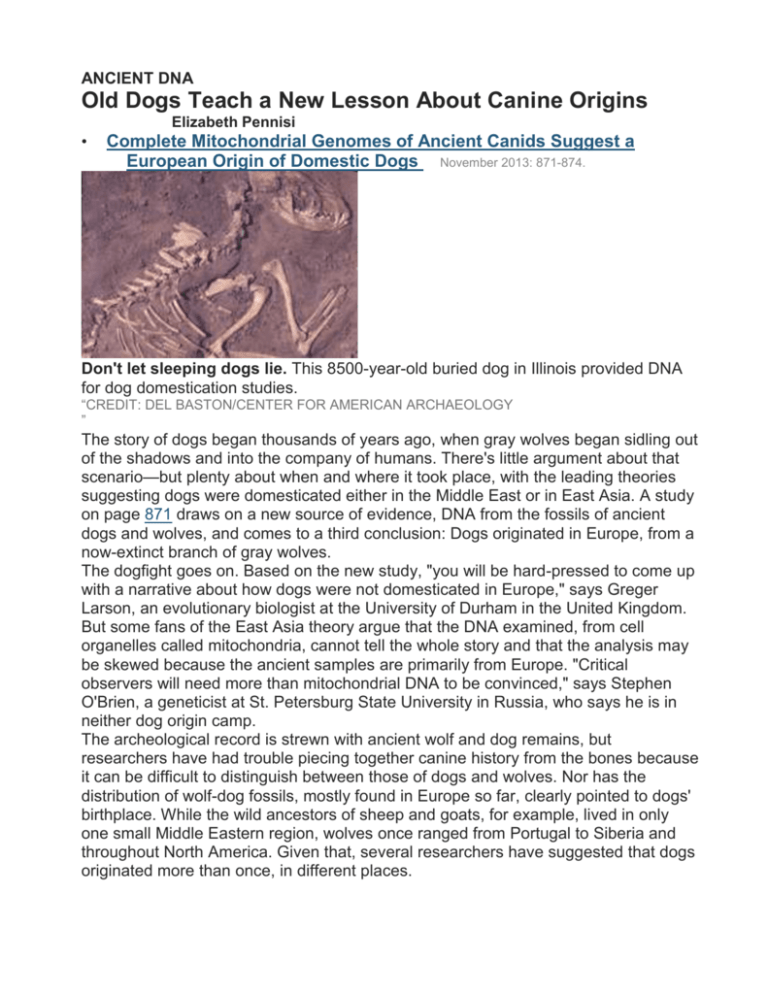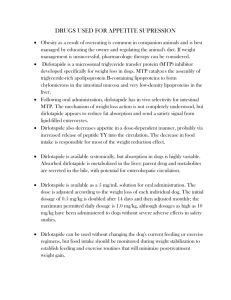Old Dogs Teach a New Lesson About Canine Origins
advertisement

ANCIENT DNA Old Dogs Teach a New Lesson About Canine Origins Elizabeth Pennisi • Complete Mitochondrial Genomes of Ancient Canids Suggest a European Origin of Domestic Dogs November 2013: 871-874. Don't let sleeping dogs lie. This 8500-year-old buried dog in Illinois provided DNA for dog domestication studies. “CREDIT: DEL BASTON/CENTER FOR AMERICAN ARCHAEOLOGY ” The story of dogs began thousands of years ago, when gray wolves began sidling out of the shadows and into the company of humans. There's little argument about that scenario—but plenty about when and where it took place, with the leading theories suggesting dogs were domesticated either in the Middle East or in East Asia. A study on page 871 draws on a new source of evidence, DNA from the fossils of ancient dogs and wolves, and comes to a third conclusion: Dogs originated in Europe, from a now-extinct branch of gray wolves. The dogfight goes on. Based on the new study, "you will be hard-pressed to come up with a narrative about how dogs were not domesticated in Europe," says Greger Larson, an evolutionary biologist at the University of Durham in the United Kingdom. But some fans of the East Asia theory argue that the DNA examined, from cell organelles called mitochondria, cannot tell the whole story and that the analysis may be skewed because the ancient samples are primarily from Europe. "Critical observers will need more than mitochondrial DNA to be convinced," says Stephen O'Brien, a geneticist at St. Petersburg State University in Russia, who says he is in neither dog origin camp. The archeological record is strewn with ancient wolf and dog remains, but researchers have had trouble piecing together canine history from the bones because it can be difficult to distinguish between those of dogs and wolves. Nor has the distribution of wolf-dog fossils, mostly found in Europe so far, clearly pointed to dogs' birthplace. While the wild ancestors of sheep and goats, for example, lived in only one small Middle Eastern region, wolves once ranged from Portugal to Siberia and throughout North America. Given that, several researchers have suggested that dogs originated more than once, in different places. View larger version: • In this page In a new window • Download PowerPoint Slide for Teaching Wolf or dog? Mitochondrial DNA from 18 fossils and from modern canids revealed that two considered doglike (italic) were not closely related to dogs at all. “SOURCE: O. THALMANN ET AL., SCIENCE ” Those hunting for the first Fido have turned to the DNA of modern animals for clues. In 2002, geneticist Peter Savolainen of the Royal Institute of Technology (KTH) in Stockholm, Ya-ping Zhang at the Kunming Institute of Zoology in China, and their colleagues analyzed small pieces of mitochondrial DNA (mtDNA) from dozens of wolves and hundreds of dogs around the world. They found the greatest genetic diversity—a potential marker of a species' origin—in southern East Asia, implying that dogs were domesticated there. Their later work on the complete mitochondrial genomes and Y-chromosomes of dogs, wolves, and coyotes supported this conclusion. But in 2010, Robert Wayne from the University of California, Los Angeles, and his colleagues analyzed 48,000 markers across the whole genomes of hundreds of dogs and gray wolves from all over the world. Dogs had more DNA sequences in common with Middle Eastern wolves than with East Asian wolves, including markers thought to be unique to animals from the Middle East. To Wayne, that suggested that dogs' ancestors came from that part of the world. Each side has argued that the other camp failed to include the widest range of samples, skewing their results. And last year, Larson and his colleagues weighed in with an analysis suggesting that modern DNA could not settle the question, because of intermixing between dogs and wolves and between different kinds of dogs in the millennia since they were domesticated. "Only ancient DNA can help," agrees JeanDenis Vigne, an archaeozoologist at CNRS, the French national research agency, and the National Museum of Natural History in Paris. Wayne had already been thinking along those lines. Since the 1990s, his team had periodically gotten permission from various archaeologists to extract DNA from ancient canid remains, but lacked the ability to sequence enough genetic material to compare. By 2010, however, with evolutionary geneticist Olaf Thalmann on board as a postdoc, the group was ready to start pulling out entire mitochondrial genomes and key parts of the nuclear DNA for study. Wayne, Thalmann (now at the University of Turku in Finland), and their team got most or all of the mitochondrial genome from 18 ancient samples, eight classified as doglike and 10 classified as wolflike, found mostly in Europe (see table, p. 786). The researchers compared the mtDNA of the samples, which ranged from 1000 to 36,000 years old, to similar sequences in modern animals: 77 dogs from a wide assortment of breeds, 49 wolves, and four coyotes. Based on sequence differences in the DNA, they built a family tree that showed the relatedness of the various samples. The analysis yielded two surprises. First, most living dogs turned out to be more closely related to ancient wolves than to modern ones. "The [gray wolf] population that gave rise to modern dogs is most likely extinct," Thalmann says. The finding supports the results of a whole-genomes study, reported in May at The Biology of Genomes meeting in Cold Spring Harbor, New York, in which Wayne's team also concluded that modern wolves are not dogs' direct ancestors. The second surprise was geographic: The ancient remains most closely related to modern dogs were all European. For example, the closest wolf relative for the largest branch of modern dogs was 14,500 years old and hailed from a cave in Switzerland; ancient dogs from Germany were the closest relatives of another modern dog branch. "This provides crucial new information," says Renato Mariani-Costantini, a pathologist at the "G. d'Annunzio" University of Chieti-Pescara in Italy who had previously published a mitochondrial DNA study of five prehistoric Italian dogs that suggested a European origin of canines. Some geneticists argue that dogs became domesticated once agriculture arose, but the new study reinforces the idea that domestication happened much earlier, among hunter-gatherers. Wayne and his colleagues calculate, based on mutation rates and observed genetic differences in their samples, that dog domestication began between 18,800 and 32,100 years ago, and that canines were well entrenched with people between 15,000 and 20,000 years ago, before humans farmed. The researchers were unable to get suitable DNA from ancient Middle Eastern canids and had no access to ancient specimens from East Asia. That's a major flaw, says Savolainen, who remains convinced that dogs originated in southern China. "It's not really an objective study." He and others also fault the work for including just a few modern wolves from the Middle East and China but dozens from Europe. "[It is] the same as if you wanted to do a study of the origins of humans and you didn't have a single sample from Africa." Furthermore, mtDNA, which is passed down from mother to daughter, "reflects a small part of the evolutionary history," says Chung-I Wu, an evolutionary biologist at the University of Chicago in Illinois. Given how much human migration there was early in dog domestication, Wu suspects that male dogs coming from outside Europe might have been bred with European dams, leading to the mitochondrial story Wayne and Thalmann propose, but not the correct overall picture of dog domestication. "Two parts of the genome can tell two different stories." Wayne and Thalmann are now trying to get good nuclear sequence data from dog and wolf fossils, as are Larson and other researchers (Science, 1 November, p. 543). But O'Brien is not sure that more complete genomes will settle the debates, given how much dogs and wolves must have muddied the genetic waters over history by interbreeding. " Genomic archaeology has its limitations and the dogs are testing it," he says. "It may settle one day, but don't count on it." The editors suggest the following Related Resources on Science sites In Science Magazine ◦ REPORT Complete Mitochondrial Genomes of Ancient Canids Suggest a European Origin of Domestic Dogs O. Thalmann, B. Shapiro, P. Cui, V. J. Schuenemann, S. K. Sawyer, D. L. Greenfield, M. B. Germonpré, M. V. Sablin, F. López-Giráldez, X. Domingo-Roura, H. Napierala, H-P. Uerpmann, D. M. Loponte, A. A. Acosta, L. Giemsch, R. W. Schmitz, B. Worthington, J. E. Buikstra, A. Druzhkova, A. S. Graphodatsky, N. D. Ovodov, N. Wahlberg, A. H. Freedman, R. M. Schweizer, K.-P. Koepfli, J. A. Leonard, M. Meyer, J. Krause, S. Pääbo, R. E. Green, and R. K. Wayne Science 15 November 2013: 871-874.





